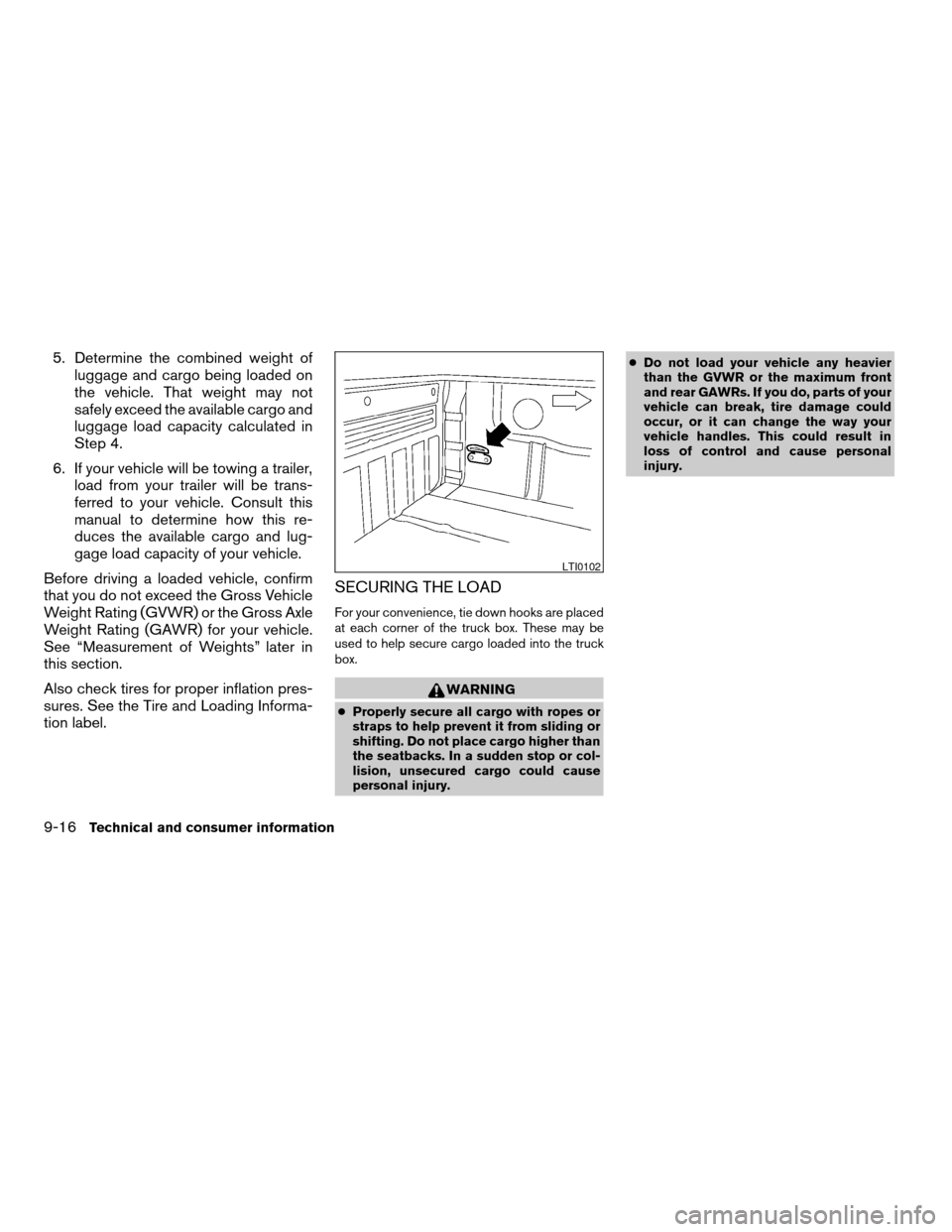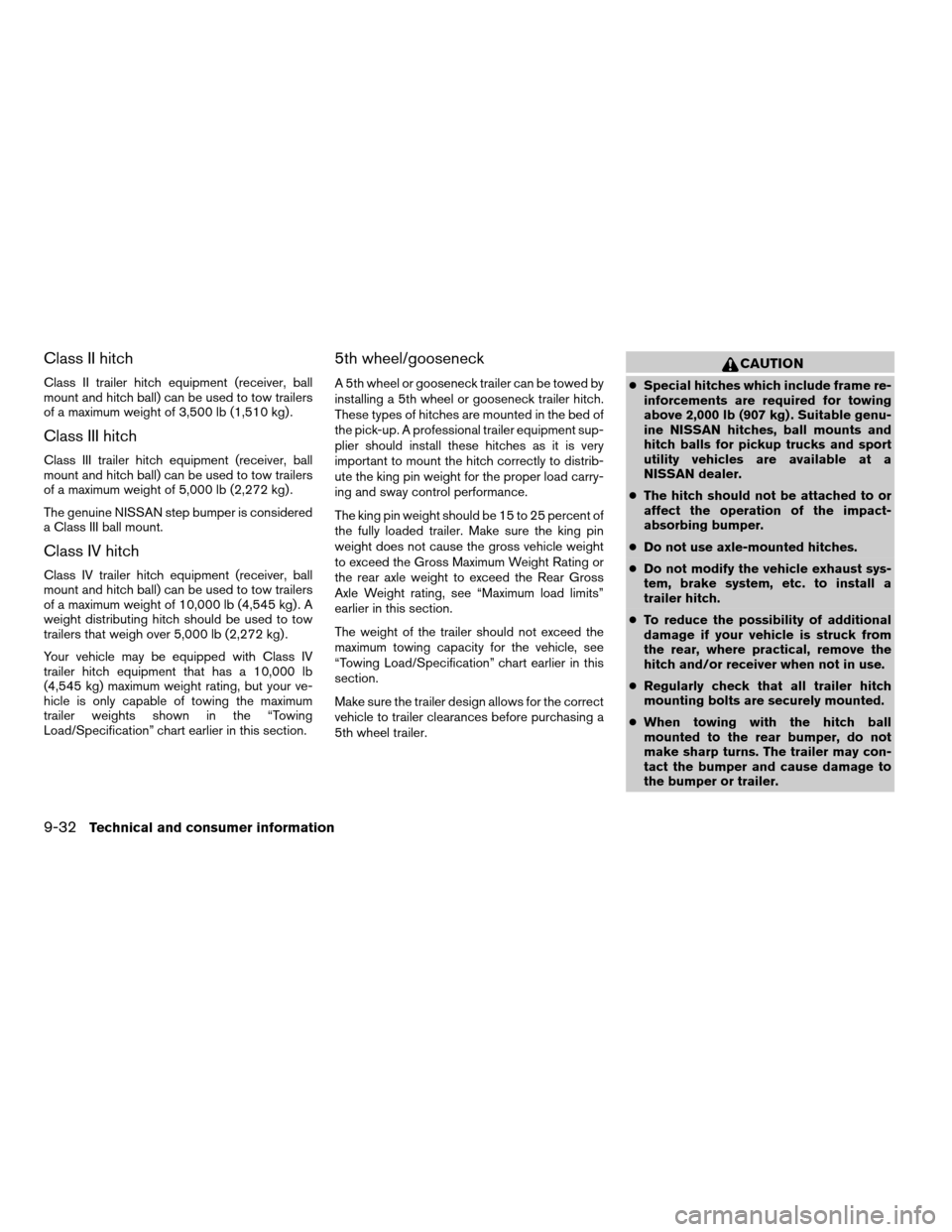2007 NISSAN TITAN load capacity
[x] Cancel search: load capacityPage 330 of 368

5. Determine the combined weight of
luggage and cargo being loaded on
the vehicle. That weight may not
safely exceed the available cargo and
luggage load capacity calculated in
Step 4.
6. If your vehicle will be towing a trailer,
load from your trailer will be trans-
ferred to your vehicle. Consult this
manual to determine how this re-
duces the available cargo and lug-
gage load capacity of your vehicle.
Before driving a loaded vehicle, confirm
that you do not exceed the Gross Vehicle
Weight Rating (GVWR) or the Gross Axle
Weight Rating (GAWR) for your vehicle.
See “Measurement of Weights” later in
this section.
Also check tires for proper inflation pres-
sures. See the Tire and Loading Informa-
tion label.
SECURING THE LOAD
For your convenience, tie down hooks are placed
at each corner of the truck box. These may be
used to help secure cargo loaded into the truck
box.
WARNING
cProperly secure all cargo with ropes or
straps to help prevent it from sliding or
shifting. Do not place cargo higher than
the seatbacks. In a sudden stop or col-
lision, unsecured cargo could cause
personal injury.cDo not load your vehicle any heavier
than the GVWR or the maximum front
and rear GAWRs. If you do, parts of your
vehicle can break, tire damage could
occur, or it can change the way your
vehicle handles. This could result in
loss of control and cause personal
injury.
LTI0102
9-16Technical and consumer information
ZREVIEW COPYÐ2007 Titan(tzw)
Owners ManualÐUSA_English(nna)
07/09/06Ðtbrooks
X
Page 338 of 368

WARNING
Overloading or improper loading can ad-
versely affect vehicle handling, braking
and performance and may lead to
accidents.
PAYLOAD WEIGHT CAPACITY
The vehicle payload weight capacity shown on
the Tire and Loading Information label, see “Tire
and Loading Information label” in this section,
indicates the maximum total weight of passen-
gers, optional equipment (air conditioning, trailer
hitch, etc) and cargo that your vehicle is designed
to carry.
Before driving a loaded vehicle, confirm that you
do not exceed the Gross Vehicle Weight Rating
(GVWR) or the Gross Axle Weight Rating
(GAWR) for your vehicle. See ’’Vehicle Loading
Information’’ earlier in this section for details.
Also check tires for proper inflation pressures.
See the Tire and Loading Information label.
MEASUREMENT OF WEIGHTS
Secure loose items to prevent weight
shifts that could affect the balance of your
vehicle. When the vehicle is loaded, drive
to a scale and weigh the front and the rear
wheels separately to determine axleloads. Individual axle loads should not ex-
ceed either of the gross axle weight rat-
ings (GAWR) . The total of the axle loads
should not exceed the gross vehicle
weight rating (GVWR) . These ratings are
given on the vehicle certification label. If
weight ratings are exceeded, move or re-
move items to bring all weights below the
ratings.
WARNING
Overloading or improper loading of a
trailer and its cargo can adversely affect
vehicle handling, braking and perfor-
mance and may lead to accidents.
CAUTION
cDo not tow a trailer or haul a heavy load
for the first 500 miles (800 km) . Your
engine, axle or other parts could be
damaged.
cFor the first 500 miles (800 km) that you
tow a trailer, do not drive over 50 mph
(80 km/h) and do not make starts at full
throttle. This helps the engine and other
parts of your vehicle wear in at the
heavier loads.
Your new vehicle was designed to be used pri-
marily to carry passengers and cargo. Remember
that towing a trailer places additional loads on
your vehicle’s engine, drive train, steering, brak-
ing and other systems.
A NISSAN Towing Guide (U.S. only) is available
on the website at www.nissanusa.com. This
guide includes information on trailer towing ca-
pability and the special equipment required for
proper towing.
TOWING A TRAILER
9-24Technical and consumer information
ZREVIEW COPYÐ2007 Titan(tzw)
Owners ManualÐUSA_English(nna)
07/09/06Ðtbrooks
X
Page 341 of 368

Towing capacities are calculated assuming a
base vehicle with driver and any options required
to achieve the rating. Additional passengers,
cargo and/or optional equipment, such as the
trailer hitch, will add weight to the vehicle and
reduce your vehicle’s maximum towing capacity
and trailer tongue load.
The vehicle and trailer need to be weighed to
confirm the vehicle is within the GVWR, Front
GAWR, Rear GAWR, Gross Combined Weight
Rating (GCWR) and Towing capacity.
All vehicle and trailer weights can be measured
using platform type scales commonly found at
truck stops, highway weigh stations, building
supply centers or salvage yards.
To determine the available payload capacity for
tongue/king pin load, use the following proce-
dure.
1. Locate the GVWR on the
F.M.V.S.S./C.M.V.S.S. certification label.
2. Weigh your vehicle on the scale with all of
the passengers and cargo that are normally
in the vehicle when towing a trailer.
3. Subtract the actual vehicle weight from the
GVWR. The remaining amount is the avail-
able maximum tongue/king pin load.To determine the available towing capacity, use
the following procedure.
1. Find the GCWR for your vehicle on the
9Towing Load/Specification9chart found
later in this section.
2. Subtract the actual vehicle weight from the
GCWR. The remaining amount is the avail-
able maximum towing capacity.
To determine the Gross Trailer Weight, weigh
your trailer on a scale with all equipment and
cargo, that are normally in the trailer when it is
towed. Make sure the Gross trailer weight is not
more than the Gross Trailer Weight Rating shown
on the trailer and is not more than the calculated
available maximum towing capacity.
Also weigh the front and rear axles on the scale to
make sure the Front Gross Axle Weight and Rear
Gross Axle Weight are not more than Front
Gross Axle Weight and Rear Gross Axle Weight
on the F.M.V.S.S./C.M.V.S.S. certification label.
The cargo in the trailer and vehicle may need to
be moved or removed to meet the specified rat-
ings.
Example:
cGross Vehicle Weight (GVW) as weighed
on a scale - including passengers, cargo and
hitch - 5,567 lb. (2525 kg) .cGross Vehicle Weight Rating (GVWR) from
F.M.V.S.S./C.M.V.S.S. certification label -
6,422 lb. (2913 kg) .
cGross Combined Weight Rating (GCWR)
from “Towing Load/Specification9chart -
14,650 lb. (6645 kg) .
cMaximum Trailer towing capacity from “Tow-
ing Load/Specification9chart - 9,200 lb.
(4173 kg) .
6,422 lb. (2913 kg) GVWR
– 5,567 lb. (2525 kg) GVW
= 855 lb. (388 kg) Available for tongue/king
pin weight
14,650 lb. (6645 kg) GCWR
– 5,567 lb. (2525 kg) GVW
= 9,083 lb. (4120 kg) Capacity available for tow-
ing
855 lb. (388 kg) Available tongue weight
/ 9,083 lb. (4120 kg) Available capacity
= 9 % tongue weight
In this case, the available towing capacity is 117
lb. (53 kg) less than the maximum towing capac-
ity due to the passenger and cargo load in the
vehicle.
Technical and consumer information9-27
ZREVIEW COPYÐ2007 Titan(tzw)
Owners ManualÐUSA_English(nna)
07/09/06Ðtbrooks
X
Page 342 of 368

TOWING LOAD/SPECIFICATION
Towing load specification chart with tow package
2WD4WD
KC CC KC CC
XE SE LE XE SE LE XE SE LE XE SE LE
Towing
Capacity *1,
*2, *39,500 lb.
(4309 kg)9,500 lb.
(4309 kg)9,200 lb.
(4173 kg)9,400 lb.
(4264 kg)9,400 lb.
(4264 kg)9,200 lb.
(4173 kg)9,400 lb.
(4264 kg)9,400 lb.
(4264 kg)9,200 lb.
(4173 kg)9,400 lb.
(4264 kg)9,300 lb.
(4218 kg)9,200 lb.
(4173 kg)
Tongue
load*2, *3950 lb.
(430 kg) –
1,425 lb.
(737 kg)950 lb. (430
kg) – 1,425
lb. (737 kg)920 lb. (417
kg) – 1,380
lb. (625 kg)940 lb.
(426 kg) –
1,410 lb.
(639 kg)940 lb. (426
kg) – 1,410
lb. (639 kg)920 lb. (417
kg) – 1,380
lb. (625 kg)940 lb. (426
kg) – 1,410
lb. (639 kg)940 lb.
(426 kg) –
1,410 lb.
(639 kg)920 lb.
(417 kg) –
1,380 lb.
(625 kg)940 lb.
(426 kg) –
1,410 lb.
(639 kg)930 lb. (422
kg) – 1,395
lb. (632 kg)920 lb.
(417 kg) –
1,380 lb.
(625 kg)
King pin
load1,425 lb.
(737 kg) –
2,375 lb.
(1077 kg)1,425 lb.
(737 kg) –
2,375 lb.
(1077 kg)1,380 lb.
(625 kg) –
2,300 lb.
(1043 kg)1,410 lb.
(639 kg) –
2,350 lb.
(1065 kg)1,410 lb.
(639 kg) –
2,350 lb.
(1065 kg)1,380 lb.
(625 kg) –
2,300 lb.
(1043 kg)1,410 lb.
(639 kg) –
2,350 lb.
(1065 kg)1,410 lb.
(639 kg) –
2,350 lb.
(1065 kg)1,380 lb.
(625 kg) –
2,300 lb.
(1043 kg)1,410 lb.
(639 kg) –
2,350 lb.
(1065 kg)1,395 lb.
(632 kg) –
2,325 lb.
(1054 kg)1,380 lb.
(625 kg) –
2,300 lb.
(1043 kg)
Gross
Combined
Weight Rat-
ing14,700 lb.
(6668 kg)14,700 lb.
(6668 kg)14,700 lb.
(6668 kg)14,700 lb.
(6668 kg)14,700 lb.
(6668 kg)14,700 lb.
(6668 kg)14,850 lb.
(6736 kg)14,850 lb.
(6736 kg)14,850 lb.
(6736 kg)14,850 lb.
(6736 kg)14,850 lb.
(6736 kg)14,850 lb.
(6736 kg)
9-28Technical and consumer information
ZREVIEW COPYÐ2007 Titan(tzw)
Owners ManualÐUSA_English(nna)
07/09/06Ðtbrooks
X
Page 343 of 368

Towing load specification chart without tow package
2WD4WD
KC CC KC CC
XE SE LE XE SE LE XE SE LE XE SE LE
Towing
capacity*1,
*36,500 lb.
(2948 kg)7,400 lb.
(3357 kg)7,200 lb.
(3266 kg)6,500 lb.
(2948 kg)7,400 lb.
(3357 kg)7,200 lb.
(3266 kg)6,500 lb.
(2948 kg)7,400 lb.
(3357 kg)7,200 lb.
(3266 kg)6,500 lb.
(2948 kg)7,400 lb.
(3357 kg)7,200 lb.
(3266 kg)
Tongue load
*3650 lb.
(295 kg) –
975 lb.
(442 kg)740 lb. (336
kg) – 1,110
lb. (503 kg)720 lb. (327
kg) – 1,080
lb. (489 kg)650 lb.
(295 kg) –
975 lb.
(442 kg)740 lb. (336
kg) – 1,110
lb. (503 kg)720 lb. (327
kg) – 1,080
lb. (489 kg)650 lb. (295
kg) – 975
lb. (442 kg)740 lb.
(336 kg) –
1,110 lb.
(503 kg)720 lb.
(327 kg) –
1,080 lb.
(489 kg)650 lb.
(295 kg) –
975 lb.
(442 kg)740 lb. (336
kg) – 1,110
lb. (503 kg)720 lb.
(327 kg) –
1,080 lb.
(489 kg)
King pin
load975 lb.
(442 kg) –
1,625 lb.
(737 kg)1,110 lb.
(503 kg) –
1,850 lb.
(839 kg)1,080 lb.
(489 kg) –
1,800 lb.
(816 kg)975 lb.
(442 kg) –
1,625 lb.
(737 kg)1,110 lb.
(503 kg) –
1,850 lb.
(839 kg)1,080 lb.
(489 kg) –
1,800 lb.
(816 kg)975 lb. (442
kg) – 1,625
lb. (737 kg)1,110 lb.
(503 kg) –
1,850 lb.
(839 kg)1,080 lb.
(489 kg) –
1,800 lb.
(816 kg)975 lb.
(442 kg) –
1,625 lb.
(737 kg)1,110 lb.
(503 kg) –
1,850 lb.
(839 kg)1,080 lb.
(489 kg) –
1,800 lb.
(816 kg)
Gross
Combined
Weight Rat-
ing12,800 lb.
(5805 kg)12,800 lb.
(5805 kg)12,800 lb.
(5805 kg)12,800 lb.
(5805 kg)12,800 lb.
(5805 kg)12,800 lb.
(5805 kg)13,000 lb.
(5896 kg)13,000 lb.
(5896 kg)13,000 lb.
(5896 kg)13,000 lb.
(5896 kg)13,000 lb.
(5896 kg)13,000 lb.
(5896 kg)
*1: The towing capacity values are calculated assuming a base vehicle with driver and any options required to achieve the rating. Additional passengers,
cargo and/or optional equipment will add weight to the vehicle and reduce your vehicle’s maximum towing capacity.
*2: Requires weight distribution hitch.
*3: The maximum towing capacity when using the genuine NISSAN step bumper as a ball mount is 5,000 lb. (2268 kg) and 500 lb. (227 kg) – 750 lb. (340
kg) tongue load, 750 lb. (340 kg) – 1,250 lb. (566 kg) king pin load.
Technical and consumer information9-29
ZREVIEW COPYÐ2007 Titan(tzw)
Owners ManualÐUSA_English(nna)
07/09/06Ðtbrooks
X
Page 346 of 368

Class II hitch
Class II trailer hitch equipment (receiver, ball
mount and hitch ball) can be used to tow trailers
of a maximum weight of 3,500 lb (1,510 kg) .
Class III hitch
Class III trailer hitch equipment (receiver, ball
mount and hitch ball) can be used to tow trailers
of a maximum weight of 5,000 lb (2,272 kg) .
The genuine NISSAN step bumper is considered
a Class III ball mount.
Class IV hitch
Class IV trailer hitch equipment (receiver, ball
mount and hitch ball) can be used to tow trailers
of a maximum weight of 10,000 lb (4,545 kg) . A
weight distributing hitch should be used to tow
trailers that weigh over 5,000 lb (2,272 kg) .
Your vehicle may be equipped with Class IV
trailer hitch equipment that has a 10,000 lb
(4,545 kg) maximum weight rating, but your ve-
hicle is only capable of towing the maximum
trailer weights shown in the “Towing
Load/Specification” chart earlier in this section.
5th wheel/gooseneck
A 5th wheel or gooseneck trailer can be towed by
installing a 5th wheel or gooseneck trailer hitch.
These types of hitches are mounted in the bed of
the pick-up. A professional trailer equipment sup-
plier should install these hitches as it is very
important to mount the hitch correctly to distrib-
ute the king pin weight for the proper load carry-
ing and sway control performance.
The king pin weight should be 15 to 25 percent of
the fully loaded trailer. Make sure the king pin
weight does not cause the gross vehicle weight
to exceed the Gross Maximum Weight Rating or
the rear axle weight to exceed the Rear Gross
Axle Weight rating, see “Maximum load limits”
earlier in this section.
The weight of the trailer should not exceed the
maximum towing capacity for the vehicle, see
“Towing Load/Specification” chart earlier in this
section.
Make sure the trailer design allows for the correct
vehicle to trailer clearances before purchasing a
5th wheel trailer.
CAUTION
cSpecial hitches which include frame re-
inforcements are required for towing
above 2,000 lb (907 kg) . Suitable genu-
ine NISSAN hitches, ball mounts and
hitch balls for pickup trucks and sport
utility vehicles are available at a
NISSAN dealer.
cThe hitch should not be attached to or
affect the operation of the impact-
absorbing bumper.
cDo not use axle-mounted hitches.
cDo not modify the vehicle exhaust sys-
tem, brake system, etc. to install a
trailer hitch.
cTo reduce the possibility of additional
damage if your vehicle is struck from
the rear, where practical, remove the
hitch and/or receiver when not in use.
cRegularly check that all trailer hitch
mounting bolts are securely mounted.
cWhen towing with the hitch ball
mounted to the rear bumper, do not
make sharp turns. The trailer may con-
tact the bumper and cause damage to
the bumper or trailer.
9-32Technical and consumer information
ZREVIEW COPYÐ2007 Titan(tzw)
Owners ManualÐUSA_English(nna)
07/09/06Ðtbrooks
X